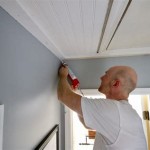If you’re looking for a way to make your home more peaceful and comfortable, soundproofing your ceiling is a great way to do it. Soundproofing a ceiling can be a complex task, but with the right materials, tools, and techniques, you can get the job done quickly and effectively. In this article, we’ll provide you with step-by-step instructions for soundproofing a ceiling and explain why it’s important.
Why Should You Soundproof a Ceiling?
Soundproofing a ceiling can be beneficial for a variety of reasons. It can help to reduce the amount of noise that comes from upstairs neighbors, traffic, and other sources. In addition, soundproofing a ceiling can improve the acoustics in your home, making it easier to listen to music, movies, and other audio sources. Finally, soundproofing a ceiling can help to reduce energy costs, as it will help to keep heat in during the winter and out during the summer.
Materials and Tools Needed
Before you can begin soundproofing a ceiling, you’ll need to gather all of the necessary materials and tools. This includes:
- Acoustical Insulation
- Caulk
- Sealant
- Drywall Screws
- Drywall Tape
- Utility Knife
- Screwdriver
- Hammer
Step-by-Step Instructions
Once you have all of the necessary materials and tools, you can begin soundproofing your ceiling. Here are the steps you’ll need to follow:
- Remove all existing insulation material from the ceiling.
- Cut pieces of acoustical insulation to fit the ceiling and attach them to the joists using drywall screws.
- Apply caulk to the seams between the insulation pieces.
- Apply a sealant to any cracks or gaps in the ceiling.
- Cover the insulation with drywall tape.
- Attach drywall panels to the joists using drywall screws.
- Use a utility knife to cut away any excess drywall.
- Fill any holes or cracks with caulk or sealant.
- Apply a layer of sealant to the edges of the drywall panels.
- Use a screwdriver and hammer to attach the drywall panels to the joists.
Conclusion
Soundproofing a ceiling can be a complicated task, but with the right materials, tools, and techniques, it can be done quickly and effectively. We hope this article has provided you with the information you need to get the job done right. Good luck!













Related Posts









